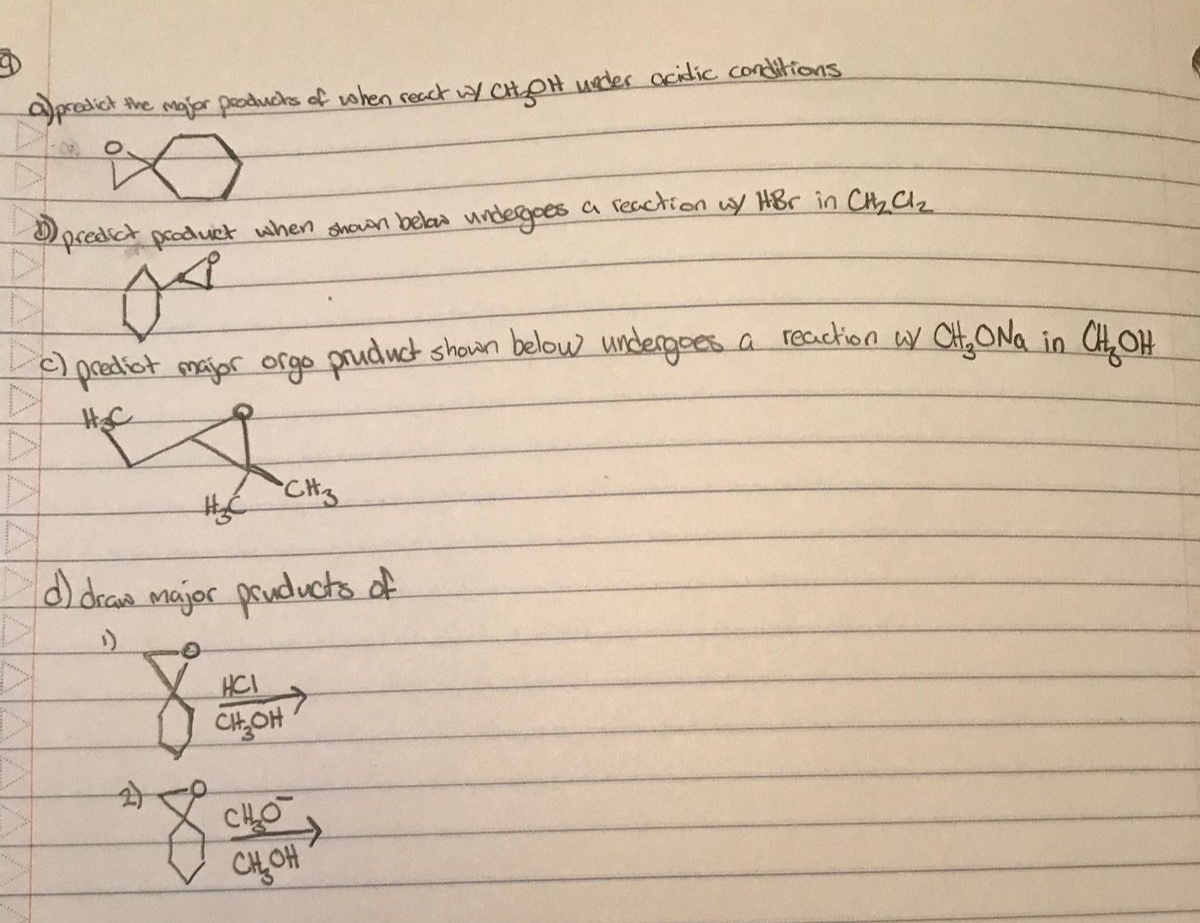a)predict the major products of when react w/ CH₂OH under acidic conditions 1)predict product when shown below undergoes a reaction wy HBr in CH₂ Cl₂ js c) predict major orgo pruduct shown below undergoes a reaction wy O₂ ONG in CH₂OH H₂C CH3 d) draw major pruducts of 1) 80 HCI CH₂OH CHO CH₂OH
a)predict the major products of when react w/ CH₂OH under acidic conditions 1)predict product when shown below undergoes a reaction wy HBr in CH₂ Cl₂ js c) predict major orgo pruduct shown below undergoes a reaction wy O₂ ONG in CH₂OH H₂C CH3 d) draw major pruducts of 1) 80 HCI CH₂OH CHO CH₂OH
Chemistry
10th Edition
ISBN:9781305957404
Author:Steven S. Zumdahl, Susan A. Zumdahl, Donald J. DeCoste
Publisher:Steven S. Zumdahl, Susan A. Zumdahl, Donald J. DeCoste
Chapter1: Chemical Foundations
Section: Chapter Questions
Problem 1RQ: Define and explain the differences between the following terms. a. law and theory b. theory and...
Related questions
Question
please help with all parts

Transcribed Image Text:### Organic Chemistry Problem Set
#### Question A
Predict the major product(s) of the reaction when the epoxide shown reacts with CH₃OH under acidic conditions.
**Diagram:**
- The epoxide is depicted as a three-membered cyclic ether with one oxygen atom embedded in a six-membered carbon ring.
#### Question B
Predict the product when the alkene shown below undergoes a reaction with HBr in CH₂Cl₂.
**Diagram:**
- The alkene is shown as a cyclohexene ring with one of the carbon atoms bonded to a methyl group (CH₃).
#### Question C
Predict the major organic product when the epoxide shown below undergoes a reaction with CH₃ONa in CH₃OH.
**Diagram:**
- The epoxide is depicted as a three-membered cyclic ether with two methyl groups attached to the ring, one on the C-1 position and another on the C-2 position of the epoxide.
#### Question D
Draw the major products of the following reactions:
1) Reaction of the epoxide with HCl in CH₃OH.
2) Reaction of the bicyclic compound with CH₃O⁻ in CH₃OH.
**Diagrams:**
1) The bicyclic compound is depicted resembling a norbornane structure, specifically containing a three-membered ring fused to a six-membered ring.
2) The bicyclic compound is depicted undergoing a reaction with methoxide (CH₃O⁻) in methanol (CH₃OH).
These problems require knowledge of reaction mechanisms involving epoxides and alkenes, specifically under acidic and nucleophilic conditions. The expected outcomes focus on understanding how these reagents interact with the given structures, considering regioselectivity and stereochemistry principles.
Expert Solution
Step 1
Given reactions:

Step by step
Solved in 2 steps with 2 images

Knowledge Booster
Learn more about
Need a deep-dive on the concept behind this application? Look no further. Learn more about this topic, chemistry and related others by exploring similar questions and additional content below.Recommended textbooks for you

Chemistry
Chemistry
ISBN:
9781305957404
Author:
Steven S. Zumdahl, Susan A. Zumdahl, Donald J. DeCoste
Publisher:
Cengage Learning

Chemistry
Chemistry
ISBN:
9781259911156
Author:
Raymond Chang Dr., Jason Overby Professor
Publisher:
McGraw-Hill Education

Principles of Instrumental Analysis
Chemistry
ISBN:
9781305577213
Author:
Douglas A. Skoog, F. James Holler, Stanley R. Crouch
Publisher:
Cengage Learning

Chemistry
Chemistry
ISBN:
9781305957404
Author:
Steven S. Zumdahl, Susan A. Zumdahl, Donald J. DeCoste
Publisher:
Cengage Learning

Chemistry
Chemistry
ISBN:
9781259911156
Author:
Raymond Chang Dr., Jason Overby Professor
Publisher:
McGraw-Hill Education

Principles of Instrumental Analysis
Chemistry
ISBN:
9781305577213
Author:
Douglas A. Skoog, F. James Holler, Stanley R. Crouch
Publisher:
Cengage Learning

Organic Chemistry
Chemistry
ISBN:
9780078021558
Author:
Janice Gorzynski Smith Dr.
Publisher:
McGraw-Hill Education

Chemistry: Principles and Reactions
Chemistry
ISBN:
9781305079373
Author:
William L. Masterton, Cecile N. Hurley
Publisher:
Cengage Learning

Elementary Principles of Chemical Processes, Bind…
Chemistry
ISBN:
9781118431221
Author:
Richard M. Felder, Ronald W. Rousseau, Lisa G. Bullard
Publisher:
WILEY